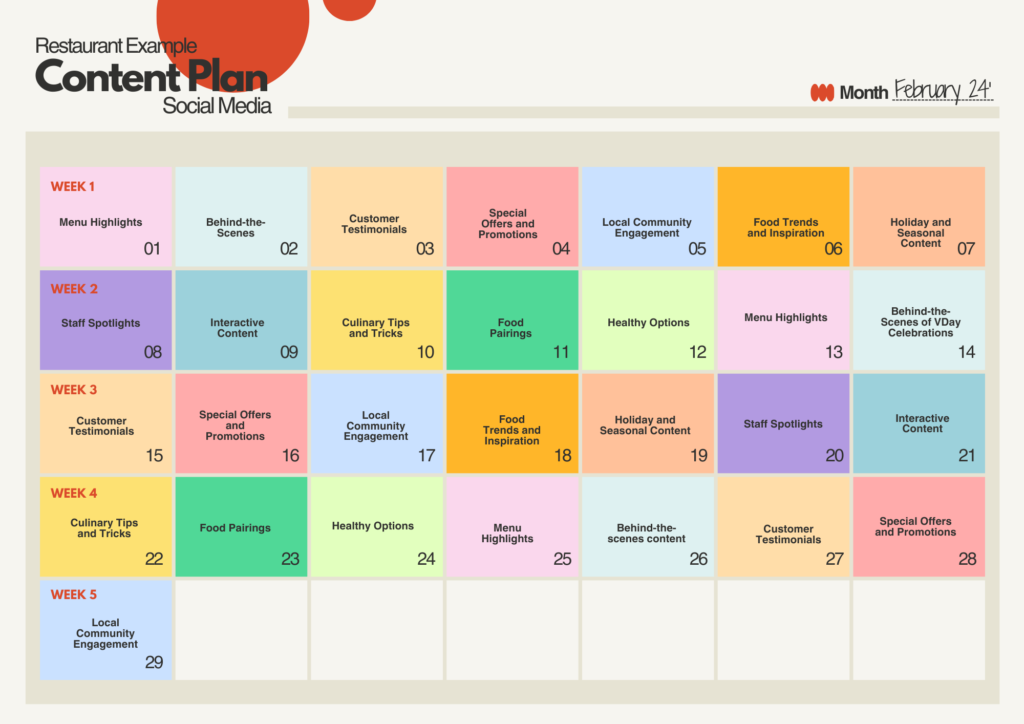Using content pillars in a social media strategy for restaurants is a great way to organize and diversify your content while maintaining a consistent brand identity. In this post, I’ll walk you through my method for using content pillars to build a robust posting content calendar for my restaurant clients.
Let’s start with a simple overview of all of the steps before moving on to the details….
Step 1: Identify the Content Pillars: Define the key themes or topics that align with your restaurant’s brand and resonate with your target audience. These become your content pillars, representing the core aspects of your restaurant. Also, maintain a consistent visual and tonal style across all content pillars. This consistency helps in building brand recognition and reinforces the identity of your restaurant.
Step 2: Create a Posting Schedule: Plan a posting schedule that rotates through your content pillars. This ensures your social media content remains varied and doesn’t become repetitive. I like to plan for the whole month, but it can be as short as seven days.
Step 3: Diversify Content Types: Each content pillar should encompass various content types, such as images, videos, infographics, and text posts. This diversity keeps your feed visually engaging and caters to different preferences among your audience. Incorporate interactive content, such as polls, quizzes, or contests, within your pillars. Encourage followers to share their experiences, opinions, or photos related to each pillar. This boosts engagement and creates a sense of community. Feel free to introduce theme days or special events aligned with your content pillars. For example, you could have “Taco Tuesday” for a Mexican restaurant or “Chef’s Special Thursday” to highlight unique dishes.
Step 6: Utilize User-Generated Content (UGC): Encourage customers to share their experiences by using a branded hashtag or tagging your restaurant. Repost UGC that aligns with your content pillars. It not only diversifies your content but also builds a sense of community.
Step 7: Monitor and Analyze Performance: Regularly analyze the performance of your content using social media analytics. Identify which content pillars resonate most with your audience and adjust your strategy accordingly.
Step 8: Adapt to Trends: Stay informed about social media trends and incorporate them into your content strategy when relevant. This demonstrates that your restaurant is current and engaged with the online community.
Section 2: Example Content Pillars for Restaurants:
Congrats, you made it to the end and it looks like we can continue with the details. To make things easier, I’ve listed the content pillars that I currently use for managing social media accounts for restaurants. I’ve generalized it a bit so it can be used with multiple types of restaurants (cafes, quick service, fine dining, etc.).
Topics:
Menu Highlights: Showcase signature dishes, new menu items, or chef’s specials. Example: High-quality photos or videos of the restaurant’s best-selling dishes.
Behind-the-Scenes: Offer a glimpse into the kitchen, introduce chefs, or share the story behind the recipes. Example: Short videos showing the chef preparing a popular dish.
Customer Testimonials: Share positive reviews, customer photos, or testimonials. Example: A collage of customer reviews or a repost of a customer’s photo enjoying a meal.
Special Offers and Promotions: Announce promotions, discounts, or special events. Example: Graphics promoting happy hour discounts or a weekend special.
Local Community Engagement: Participate in or promote local events, sponsorships, or partnerships. Example: Photos from a community event the restaurant sponsored or participated in.
Food Trends and Inspiration: Stay current with food trends, share food-related tips or feature trending ingredients. Example: A post highlighting a trendy dish or an ingredient with a unique recipe.
Holiday and Seasonal Content: Tailor content to holidays, seasons, or special occasions. Example: Themed posts for Valentine’s Day, Halloween, or a seasonal menu update.
Staff Spotlights: Introduce team members, share their stories, or showcase their favorite dishes. Example: Profiles of kitchen staff with their favorite menu items.
Interactive Content: Engage followers with polls, quizzes, or contests. Example: A poll asking followers to vote for the next featured dish.
Culinary Tips and Tricks: Share cooking tips, recipe snippets, or cooking hacks. Example: A short video demonstrating a cooking technique used in the restaurant.
Food Pairings: Suggest wine pairings, dessert combinations, or complementary dishes. Example: Graphics or posts recommending the perfect wine for a specific dish.
Healthy Options: Highlight healthy menu choices or provide nutritional information. Example: A post featuring a nutritious and delicious salad option.
Section 3: Example Content Posting Plan for Restaurants:
Here’s an example of what it looks like when all of the content pillars are used throughout the month.




